Things That Matter: Operationalizing Empathy: Part 3: Encapsulating Empathy

- Part 1: the Need for Empathy
- Part 2: How to Establish Empathy
- Part 3: How to Encapsulate Empathy
- Part 4: How to Harness Empathy
Empathy is the root of better relationships. We know this on a personal level. But empathy – actively understanding and responding to the other party’s perspective and priorities – is often almost entirely missing between organizations.
In this series, we’re seeing how empathy is based around the Things That Matter – in particular how capturing and making the Things That Matter measurable as Value Codes makes it possible to harness empathy – and in this part, we’ll look at how to encapsulate empathy between organizations.
We finished last time on the need to “properly” encapsulate the empathy established through surfacing the Things That Matter in a relationship – the essential next step.
This step is absolutely pivotal, and it involves capturing the Things That Matter appropriately, before re-expressing them as what we call Value Codes.
Capturing the Things That Matter
As you’ll see throughout this site – especially this article – we recommend using a simple, clear and consistent format something like this:
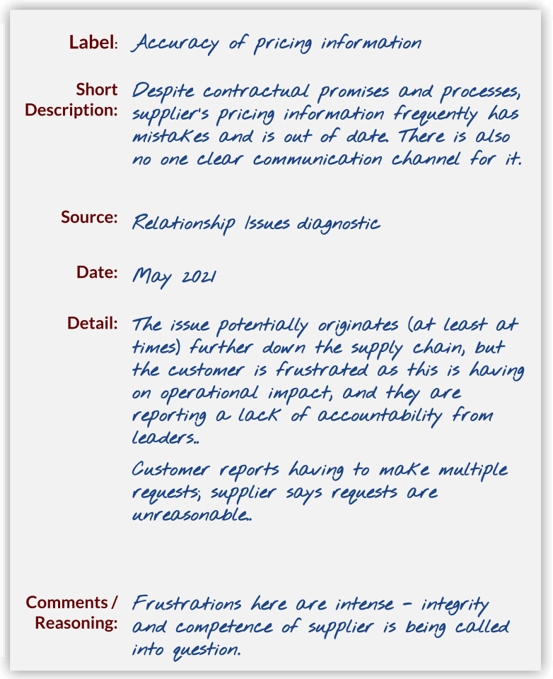
Note how this template captures each Thing That Matters in different levels of detail: an identifying Label, a short Description to make clearer what that Label means, and Detail to capture more richness.
There are lots of benefits to having content captured in this way, but the main one is that it will help you to develop measures for these Things That Matter – measures that introduce objectivity and precision to what’s so far been mostly subjective and high-level.
Scoping the Value Codes
We call these measures “Value Codes”, and we call the process of developing them “Value Coding” – all beginning by identifying the topics covered by the Things That Matter to then consolidate them into a list of proposed measures.
Let’s now focus in on our example – Accuracy of pricing information – which comes from an actual diagnostic we ran, and there are several topics involved:
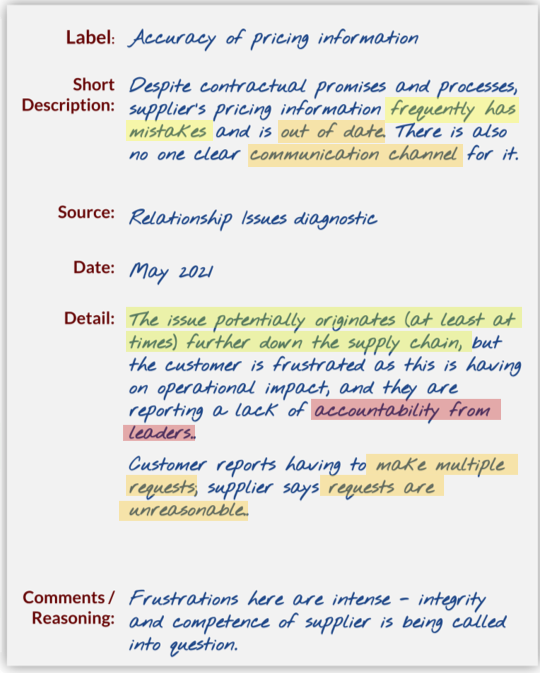
The first thing that really leaps out in the Detail is “frequently has mistakes” (highlighted near the top in yellow), so we know there’s a topic of “Quality of Information”.
Next, just after the point about mistakes, there’s a mention of that information being “out of date” – highlighted in orange – and lower down in the detail (also highlighted in orange) the customer is saying they have to make “multiple requests” for that information (and just after that, the supplier felt that those requests were “unreasonable”).
Back up near the top, you see that the question of “communication channels” came up – orange highlight again – and put that all together, and that’s a topic of “Exchange of Information”.
Next, highlighted in lime green at the start of the Detail section, we see that the accuracy issue may begin somewhere down the supply chain; in other words, “Supply Chain Visibility” is coming up
And last but not least, in the middle of the Detail section – highlighted red – there were possible issues with “Leadership Accountability”.
So, four topics – each needing a Value Code – but don’t panic: it’s not that each Thing That Matters needs four Value Codes:
- You’ll find as you process them and consolidate topics that the same ones will come up again and again, representing underlying factors and patterns.
- You can also select and adapt existing Value Codes (we have 100s and our partners have often built up their own libraries).
- We’ve been working with large language models to support the drafting process.
But on that note, let’s now go into the detail of how a Value Code is put together.
Developing a Value Code
Again we have a template:
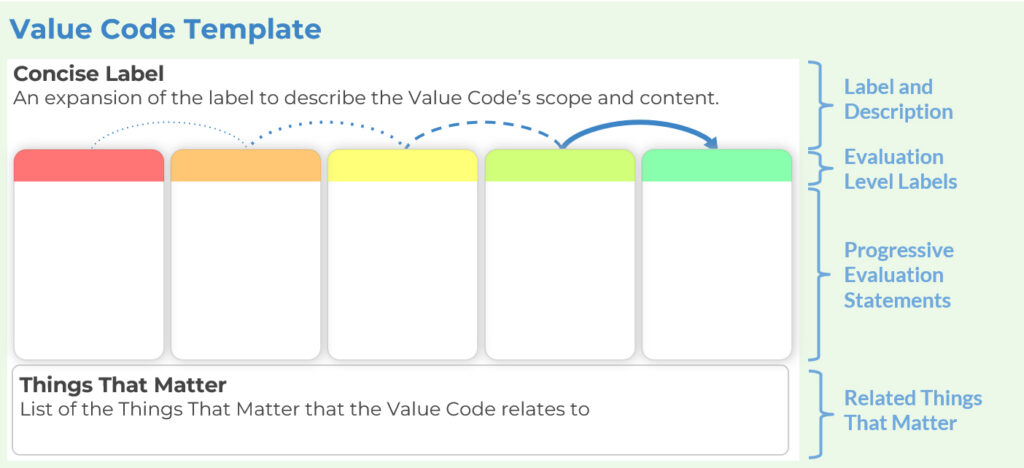
- It starts with a concise Label and Description at the top to clearly identify the measure, and to describe its scope and content.
- Below that is a set of five progressive evaluation statements, each of which will have a label.
- Then, at the bottom, there’s somewhere to capture the Things That Matter that the measure relates to, which is crucial to provide context for the measure, and to explain later why it’s there.
Now let’s use the last of the required Value Codes from our example Thing That Matters – Leadership Accountability – and we already know that the Thing That Matters it related to (down at the bottom) was “Accuracy of Pricing Information”:
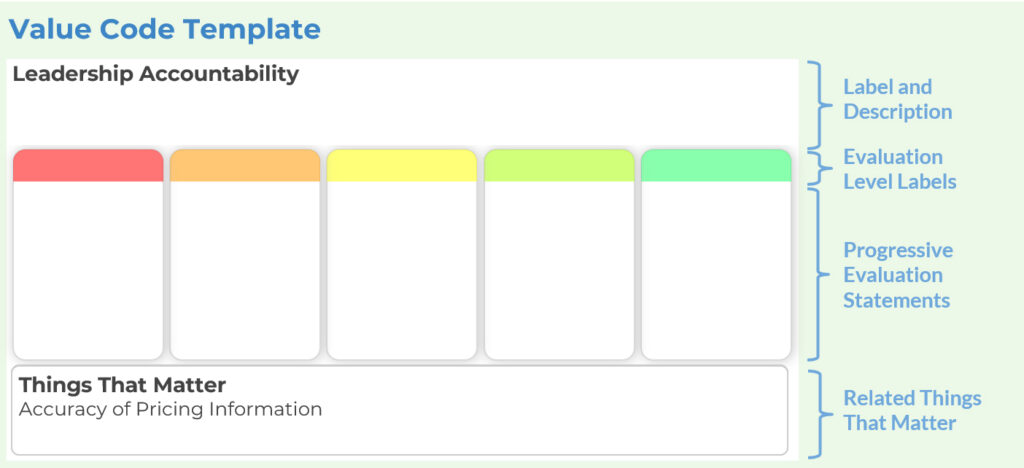
Next, we need to expand on the Value Code‘s Label and describe its scope and content with the Description.
This involves thinking about the different factors that are involved, and that would flow through (and differentiate) the evaluation statements. In this example, we included the extent of accountability, how willingly leadership accepted that accountability, how leadership performance was measured and reviewed, and whether this all led to change:

The Value Code is starting to take shape, so now for the evaluation statements below, starting with a set of labels – in this case, a fairly standard progression of Failing through to Best Practice – and then the detail of those statements:
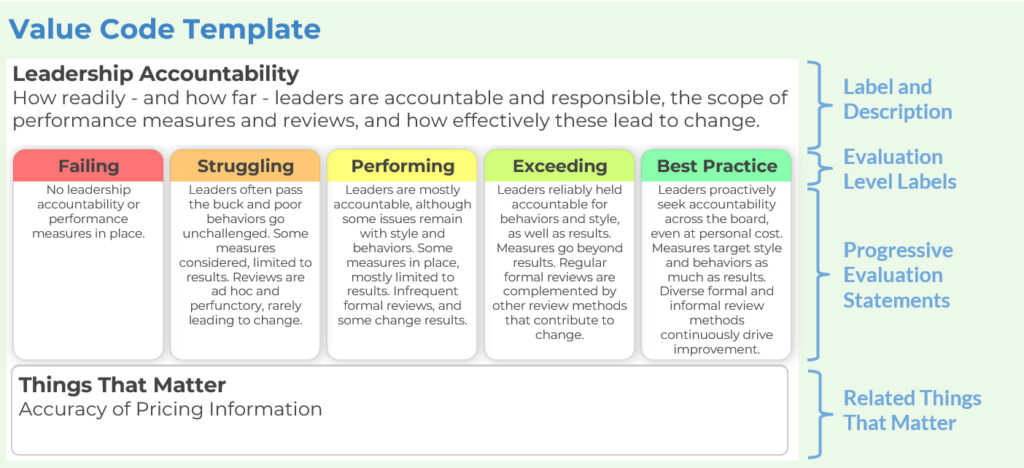
We recommend starting with the lowest level as that’s easiest – it’s usually just that there’s no sign of whatever the measure is about actually happening (certainly true above!) – and then the highest level, to bookend and frame the levels in the middle, and this is essentially the very best that can be imagined.
Filling in the middle three statements usually takes more time and effort, because you’re aiming for the differences between the statements to suggest the necessary improvement actions:
- The second level is usually below-average, but already in this example, you see that compared to “Failing”, measures are at least considered and there are reviews, even if they are ad hoc: some minor improvements
- The middle level is then typically an acceptable level of performance: a reasonable baseline, and note here how measures go from being “considered” to being in place, and formal reviews are now introduced: more potential improvement actions
- The fourth level is generally intended to be where current good practice is: here, reliable and broad accountability, wider measures and various review methods – again, improvement actions.
And there you have a Value Code measure!
Value Codes and Things That Matter
You’ve now got descriptions in place of what good looks like for an important topic – and what it doesn’t look like – all expressed in clear and mostly objective language that is understandable and relatable for everyone, and all tied back to a Thing That Matters.
With the other Value Codes you’d assemble for the topics in that Thing That Matters, you’d be able to effectively measure that Thing That Matters from all the angles that it covers:
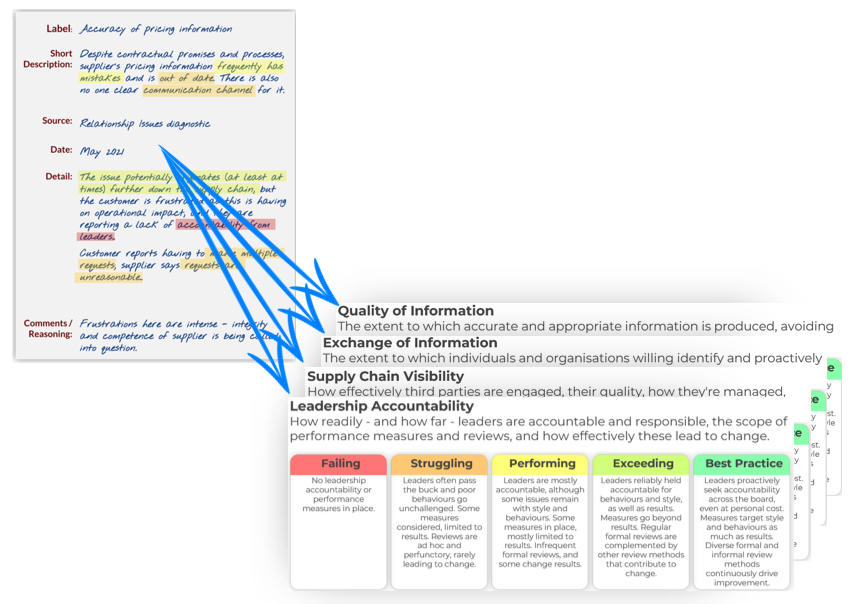
Of course, in this example, “Accuracy of pricing information” has a reasonable degree of objectivity about it, but subjective Things That Matter increasingly dominate, so this process is mostly about putting measures on “intangibles” that almost always fall outside the scope of formal relationship management.
In other words, making it possible to actually measure relationship value in its widest sense.
To make that point even clearer, let’s now look at what happens when you’ve got a set of Things That Matter with associated Value Codes:

Note the clear contrast between the mostly subjective and high-level Things That Matter on the left and the much more objective and specific Value Codes on the right.
And, really importantly, note the interconnectivity – e.g. “Exchange of Information” on the right doesn’t just trace back to Accuracy of Pricing Information on the left (the blue arrow); it also traces back to Improving Communications (the red arrow) and Consistency of Messaging (the purple arrow).
Progressing a Value Code is therefore likely to deliver benefits to multiple Things That Matter, and we’ve now seen how to encapsulate the empathy established in the first step of the Three Step Process: measures that are purely driven by what matters.
There’s nothing external, imposed or distracting; Value Codes make it possible to measure intangibles; they have the scope to help you make progress on several fronts at once; they’re therefore totally relevant to, and measurable at, the front line.
But how do you put Value Codes to use…? That’s what we’ll look at next time.

